 |
| Convict Lumber Yard at Newcastle showing re-created site of the main building. |
The scene of an extensive archaeological dig between 1989 and 1992, the site today houses the remains of one of the oldest surviving convict work places in Australia. It also marks the birthplace of industry in Newcastle.
From 1804 to 1822, Newcastle was a penal settlement established for the punishment of secondary offenders. Convicts were employed in the coal, timber and lime-burning industries. An area near the government wharf at the bottom of George Street (now Watt Street) was used for storage of these materials. It became known as the Lumber Yard. A convict barracks and workshop were built on the site.
When Newcastle became a free settlement in 1822 some convicts were retained there to work in the coal mines. The building was used as a carpenter' and wheelwright's 'shop. In 1831 when the government withdrew from coal mining, the Lumber Yard was used to house convicts employed in the building of Nobbys Breakwater which was completed in 1846. After a period in private use the building was destroyed by fire in 1851. Sand drifts covered the site so preserving the convict relics.
A walk through the site today is very interesting as the story of the Lumber Yard is re-created from the discoveries of the archaeological excavations. These showed evidence of heavy industry including tools, forges and saw pits. Sections of the lower walls of the barracks and floor paving were also uncovered. There was still some evidence of the fire.
 |
| Approaching the site from Watt Street |
The top of a well whose paving and stonework materials may have been re-used from ruined buildings of the convict era, is a prominent feature.
The remains of the footings of the Guardhouse and the Sergeant's Quarters have also been re-created and sited in steel structures.
 |
| Location of the Guard House site |
 |
| Another view of the Guardhouse site |
 |
Location of the footings of the Sergeant's Quarters which
extend into the present Customs House site. The footings were
uncovered by excavation in 1992.
|
****************************************************************************
History Services NSW has extensive records of convicts who were assigned to the Newcastle area.
If you are researching a convict ancestor who was assigned to the Newcastle area, you should go to our website at: http://www.historyservices.com.au/convicts.htmI also refer you to my previous blog of 28 March 2010, Governor Macquarie Visits Newcastle
Blog prepared by Mary McGuinness
All photos taken in October 2012





















































